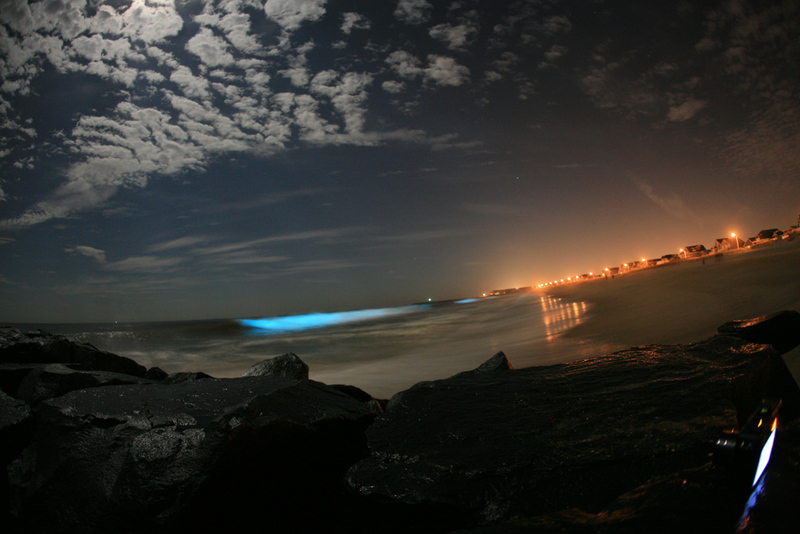AMAZING BLUE LIGHTS ARE ALIVE!

In waters surrounding southern Australia, near Tasmania, billions of single-celled algae or plant plankton, called Noctiluca scintillans, emit light when they are disturbed by waves or currents to scare off predators.
Thanks to climate change, warming oceans may have contributed to the spread of bioluminescence in recent years.

In waters surrounding southern Australia, near Tasmania, billions of single-celled algae or plant plankton, called Noctiluca scintillans, emit light when they are disturbed by waves or currents to scare off predators.
Thanks to climate change, warming oceans may have contributed to the spread of bioluminescence in recent years.

The most common bioluminescent creatures are speck-sized, plant-like dinoflagellates. When they proliferate, or “bloom,” they cause a phenomenon known a “red tide.” They flash brilliant blue to scare off predators when they're disturbed or caught in a wave.

Abraliopsis Squid has small light organs on the underside of its body, which it uses for camouflage, to protect it from predators swimming below.

The Antarctic krill is a very prolific bioluminescent creature. It is a pelagic crustacean native to the waters surrounding Antarctica, serving a critical role near the bottom of the food chain -- whales and seals are at the top.
Scientists estimate the total combined biomass of these to exceed a hundred million metric tons, more than the biomass of the entire global human population.

Many Ctenophores, aka comb jellies, sea gooseberries, sea walnuts, or Venus's girdles, are bioluminescent.

The Tomopteris sea worm, a polychaete, is one of the few creatures that make yellow light, although photos tend to show their light as bluish green.

The siphonophore, which appears to be a single organism, each specimen is actually a colony composed of many individual transparent floating animals. Collectively, they resemble jellyfish. The best known species is the dangerous Portuguese Man o' War (Physalia physalis). The siphonophore one of only two lifeforms found to produce a red light, the other being the scaleless dragonfish (Chirostomias pliopterus).

Recently, new species of millipede was discovered to develop bioluminescence as a means to survive the oxidative stress produced by the hot, dry environment found in California deserts, according to study published in the Proceedings of the National Academy of Sciences.
The study, led by Paul Marek, an assistant professor of entomology in the College of Agriculture and Life Sciences, showed that this discovery, based on a millipede that hadn't been seen in 50 years, points to evidence of small evolutionary steps and gives insight into the early evolutionary role of bioluminescence as compared to its modern day function.
"Because we're looking at a trait that has been shaped by millions of years of evolution, these traits often bear little resemblance to their ancestral form," Marek said.

This glowing millipede, Xystocheir bistipita, is smaller than its cousins. It lives at a lower elevation with few predators. It was not originally thought to belong to the known genus of millipedes that glow called Motyxia. But, after sequencing its DNA, it was found to be related after all and its name was changed to Motyxia bistipita.
M. bistipita glows green-blue due to the reaction of a magnesium-based photoprotein. Its bioluminescence evolved to become a bright warning signal against predators for nocturnal millipedes that live at higher elevations.
Interestingly, the level of glow correlated to the level of toxicity in millipedes -- they have cyanide glands!

Read more about Blue Green Beauty all this week on BeautifulNow. And check out more beautiful things happening now in BN Wellness, Impact, Nature/Science, Food, Arts/Design, and Travel, Daily Fix posts.


Do you have amazing photos? Enter them in this week’s BN Photo Competition.


